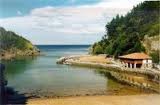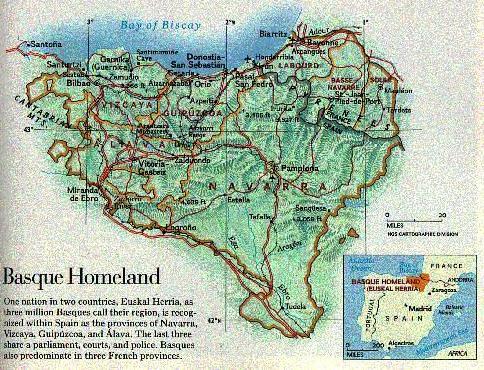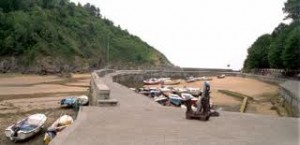This monastery is located near the town of Bolibar (yes, Simón Bolivar the liberator of the Spanish colonies in South America had his ancestors here), belonging to Markina-Xemein (a beautiful but unknown town, where the University of Jai-Alai-Basque pelota- is located). The building is not magnificent, I´d say it´s humble and appropriate for praying and silence…but it is surrounded by a most beautiful scenery, green meadows and valleys, one after the other, and by the magnificent mountains of the Basque Country. It´s open to visitors and it´s also a hospice, where you can rest and share the meditative life of the monks. For more info, https://monasteriozenarruza.net/, available in English and other languages.
Author Archives: Leire Gaceo
Basque Traditions: the Txarriboda, or Pig Slaughter
By mid November climate changes and winter settles in the Basque Country. Then, in many “baserris“, Basque farm houses, people get ready for the celebration of the txarriboda, a centuries old event that was intended to assure the daily intake of food for the next few months. The baserritarras, of owners of the farm, call their friends and neighbours and settle a date for the txarriboda or pig slaughter. They choose the biggest one of their swines and feed him well in the weeks prior to the big day. It´s a big party for everyone, and kids are -usually- also (passive) spectators. The pig is laid down and the butcherer cuts his throat deep and long, blood spurting down into a bucket, where it´s collected to make the diverse pork products afterwards. Hairs are burnt with wooden sticks, pig is cleaned and “sanitized”. Men kill and cut the pig, women make the food.
Once the pig is dissected, cut in half, his blood collected…the feast of the preparation of food begins. Meanwhile, there may be music on the frontyard of the farm, and people dancing, and friends socializing having some drinks and food. There´s normally a big table and food and drinks are laid on it, so everybody enjoys the party. Morcillas (blood sausage with rice or vegetables), chorizo (red sausage, spicy or not), bacon, ribs, ham,…, everything is stuffed and made and then hung on to the ceiling on a fresh space to cure for a few weeks. Deliciously fresh, natural, preservative free…a real pleasure to your senses once they are cured enough to eat.
Of course, a veterinarian has certified the good health of the pig and of the products that are obtained from it…this is a modern society too, despite its centuries old traditions.
I wanted to include some videos, but as they may be hard on your eyes 🙂 you may just type Txarriboda on Youtube…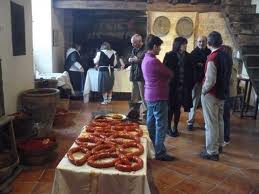
The Church (Hermitage) of Santa María de la Antigua, Zumarraga
Absolutely off the beaten path, and hardly visited by any foreign tourist, in Zumarraga lies the “cathedral” of the Basque hermitages. It´s believed that this amazing church was built on the remains of a XII century fortress. While the outside walls and façade are austere and without much interest, the interior is surprisingly outstanding, completely covered in oak wood coffering. There´s a complex wooden framework all over the ceiling, that makes of the inside of this big hermitage a beautiful, relaxing sight. If there´s someone singing on the choir, as it happened during my visit, the effect is simply breathtaking.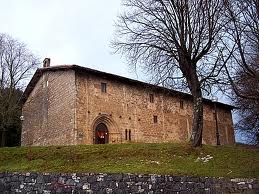
Together with the sanctuaries of Loiola and Arantzazu, it is part of the Route of the Three Temples in the Ignatian Land (founder of the Jesuits). The legend says that the church is made of the stones thrown by the Giants that inhabited the Basque Country before the arrival of christianism, who wanted to destroy it, as churches were a menace for their survival.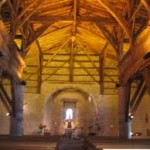
If you really want to see a different church, in a non touristy part of the Basque Country, but close to eveywhere you may stay…this is the place.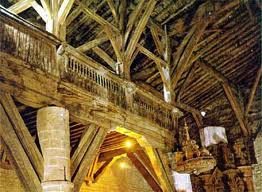
Olentzero, the Basque Santa
Basque children can´t complain when it comes to receiving presents…they get them from two sources: one is the Olentzero (on Dec 25), and the other one are the Three Wise Men or the Three Magic Kings (on Jan 6)…dates that are very conveniently separated in time.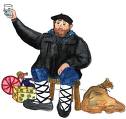
The first character is the coalmaker that lives up in the woods in the Basque mountains, and descends to town to give presents to the children on Christmas Eve. He smokes in a pipe, is normally dressed in traditional costumes and wears a Basque beret. He even has a girlfriend, Maridomingi, that wears the weirdest hat…Originally he was not very smart, a big eater and drinker and his intentions towards children were not the best (I´m not talking about paedofilia here, it´s more crime and assassination….). And he smokes in pipe!!!!
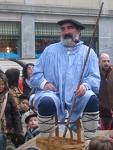 Olentzero´s house can be visited and all kids are most welcome. It´s located in a very old farm house in the centre of Mungia and it´s like a Basque mythological theme park (in a very local and modest way) that shows Basque children an important part of our myths and legends, www.izenaduba.com.
Olentzero´s house can be visited and all kids are most welcome. It´s located in a very old farm house in the centre of Mungia and it´s like a Basque mythological theme park (in a very local and modest way) that shows Basque children an important part of our myths and legends, www.izenaduba.com.
 Olentzero is part of the pre-Christian pagan traditions in the Basque Country, that lost its importance throughout the centuries and was rapidly substituted by the Three Magic Kings, the most popular present bearers in Spain. Nowadays both characters represent a peaceful conviviality in the innocent children´s minds, and both have their big parade in all towns prior to the magic night.
Olentzero is part of the pre-Christian pagan traditions in the Basque Country, that lost its importance throughout the centuries and was rapidly substituted by the Three Magic Kings, the most popular present bearers in Spain. Nowadays both characters represent a peaceful conviviality in the innocent children´s minds, and both have their big parade in all towns prior to the magic night.
Basque Sports…Overly Popular Over the Centuries
 Basques are famous all over Spain because we are considered to be very strong (a myth? maybe…) and big lovers of traditions. That mixture is represented on Basque sports, that are mainly based on strength. There are dozens of sports that are regularly played in local leagues. The most known is Basque Pelota (handball), you´ll surely notice that there´s a frontón (wall for handball) in every Basque town, no matter its size. Pelota has many varieties, it´s played not only with the hands, but also with “palas” (a very narrow wooden racket), “cesta punta”, “xare”,…in long and short frontones. Some examples here and here
Basques are famous all over Spain because we are considered to be very strong (a myth? maybe…) and big lovers of traditions. That mixture is represented on Basque sports, that are mainly based on strength. There are dozens of sports that are regularly played in local leagues. The most known is Basque Pelota (handball), you´ll surely notice that there´s a frontón (wall for handball) in every Basque town, no matter its size. Pelota has many varieties, it´s played not only with the hands, but also with “palas” (a very narrow wooden racket), “cesta punta”, “xare”,…in long and short frontones. Some examples here and here
Also, rural sports such as stone lifting (in its many varieties, too, with different weights, sizes, shapes,…), Stone lifting or stone pulling (men, oxen or donkeys…), grass cutting, wood axe cutting, etc…, are played (and we love to bet on them) throughout the year and mostly in summertime at the town festivals. Something very interesting and a centuries old tradition. Video here (what sounds in the back is a traditional Basque instrument, the Txalaparta)
Video here (what sounds in the back is a traditional Basque instrument, the Txalaparta)
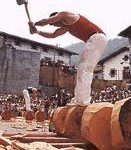 Another one very popular is the “estropadak” or “traineras”, that is, a rowing boat competition in open sea. There´s a league that starts in spring and ends in summer, and the most important competition takes place in September in the Concha estuary in San Sebastián. The winner gets a Flag (and money, too). Some videos here. We just love to keep traditions alive.
Another one very popular is the “estropadak” or “traineras”, that is, a rowing boat competition in open sea. There´s a league that starts in spring and ends in summer, and the most important competition takes place in September in the Concha estuary in San Sebastián. The winner gets a Flag (and money, too). Some videos here. We just love to keep traditions alive.
The Province of Bizkaia, in a lapse
A beautiful and original 3´ video on the highlights of the province of Bizkaia, where I live…hope you like it. Please click on the link below.
The Basilica of Saint Ignatius of Loyola, founder of the Jesuits
 You have surely heard of the Catholic order of the Jesuits, as they are present all over the world. But I´m sure you didn´t know that the founder was born in 1491 in the heart of the Basque Country, in Azpeitia. Iñigo de Loyola (born Iñigo, a Basque name, that he changed later to Ignacio), of a noble family and educated in the best manner, soon became a soldier serving the King of Castile. In 1521 he was injured while battling in Pamplona, and retired to his fortress in the valley of Loiola, near Azpeitia and Azkoitia. During his long recovery he got used to reading religious books, that made him rethink his whole life. Once recovered, he started a life of sanctity that led him to the foundation of the Jesuit order, probably the most influential in the history of the Catholic church.
You have surely heard of the Catholic order of the Jesuits, as they are present all over the world. But I´m sure you didn´t know that the founder was born in 1491 in the heart of the Basque Country, in Azpeitia. Iñigo de Loyola (born Iñigo, a Basque name, that he changed later to Ignacio), of a noble family and educated in the best manner, soon became a soldier serving the King of Castile. In 1521 he was injured while battling in Pamplona, and retired to his fortress in the valley of Loiola, near Azpeitia and Azkoitia. During his long recovery he got used to reading religious books, that made him rethink his whole life. Once recovered, he started a life of sanctity that led him to the foundation of the Jesuit order, probably the most influential in the history of the Catholic church.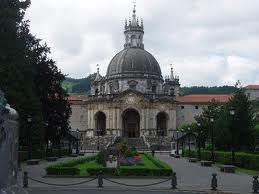
The 18th century basilica is located in a beautiful valley, surrounded by a park full of trees and by the Urola river that flows through the mountainous scenery. As you can see by the pictures, it´s a magnificent but at the same time a modest building, with a great dome covered in baroque paintings and designs. On its left hand side you can visit the birthplace of San Ignacio de Loyola, a.k.a. Iñigo de Loyola, that has been beautifully restored to its original state. You can visit both buildings, and in the fortress tower you can see the rooms as they were in the 16th century.
Right by the Basilica (or Sanctuary) there´s a nice, cozy hotel and some rural housings, as well as fine restaurants, in an atmosphere surprisingly almost tourist free. The valley offers very interesting visits, like the Ferrería de Mirandaola (Ironmongery) in the Iron Valley or the town of Idiazabal, where the world famous Idiazabal sheep cheese is made (also, the Cheese Museum deserves a visit).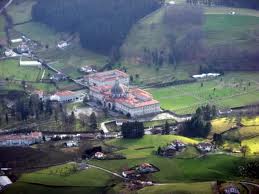
Some Useless Facts & Figures about the Basque Country, I
– Gipuzkoa is the smallest province in Spain, and the most densely populated. Capital city: San Sebastián, a.k.a. Donostia, in Basque.
– We are just 3 million Basques in Europe. Half live in Bizkaia. There´s five more times Basque descendants overseas.
– We have the highest number of blood and organ donors per capita in the world. Also, the highest income per capita in Spain.
– Basques know the Basque Country as “Euskadi“, its official name.
– Euskadi is also known as “The Little Switzerland“, because of its mountainous profile.
– 70% of our surface is forest, and a great part of it is protected.
– Basque language has seven dialects. Many Basque speakers use different words for the same concept. For instance, days of the week or months of the year.
– Basque is spoken too in the French Basque Country (Iparralde, in Basque). Euskadi is also known as Euskal Herria (an ethnic concept), 7 provinces, three forming Euskadi, another one is Navarre and the other three are in France. Around 30% of Basques speak Basque, an increasing figure.
– There are over 70 beaches in our 150 miles coast, all free from massive tourism and over construction.
– It used to rain a lot…it still does, but the feeling is that “it doesn´t rain as before”…
– The Rioja wine region is mostly in the Basque country, where top wines are produced. We also produce natural fermented cider and “txakoli“, a young wine with Denomination of Origin.
– The Athletic Bilbao soccer team, founded in 1898, has never relegated to 2nd division and plays with Basque players only.
How a XIII Century Cathedral Is Being Restored
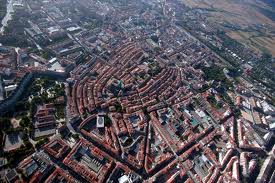 In the very centre of what´s knows as The Almond (due to its peculiar shape), that is, the historic district of Vitoria-Gasteiz, the capital of the Basque Country, there´s the Old Cathedral of St Mary´s. A few years ago, a very interesting project was born: the restoration of this Cathedral to stop its decaying process, seemingly unstoppable at the time. They have a great motto, Open For Reworks, (Abierto Por Obras, in Spanish), and they offer guided tours with experts that show you why the Cathedral was about to collapse, what are they doing to prevent it from falling down and how are they “reconstructing” some walls and columns so the building stays as it is for several more centuries.
In the very centre of what´s knows as The Almond (due to its peculiar shape), that is, the historic district of Vitoria-Gasteiz, the capital of the Basque Country, there´s the Old Cathedral of St Mary´s. A few years ago, a very interesting project was born: the restoration of this Cathedral to stop its decaying process, seemingly unstoppable at the time. They have a great motto, Open For Reworks, (Abierto Por Obras, in Spanish), and they offer guided tours with experts that show you why the Cathedral was about to collapse, what are they doing to prevent it from falling down and how are they “reconstructing” some walls and columns so the building stays as it is for several more centuries.  Extremely interesting for art and architecture lovers, for families and kids and for everyone interested in History, with capital letters. The Old Town of Vitoria-Gasteiz offers a great array of historical monuments and it´s also well worth a visit (the Jewish quarter is very well kept and its buildings are beautiful). This project has received a good number of prizes, based on its universal interest, and you can have all relevant info on www.catedralvitoria.com, also available in English.
Extremely interesting for art and architecture lovers, for families and kids and for everyone interested in History, with capital letters. The Old Town of Vitoria-Gasteiz offers a great array of historical monuments and it´s also well worth a visit (the Jewish quarter is very well kept and its buildings are beautiful). This project has received a good number of prizes, based on its universal interest, and you can have all relevant info on www.catedralvitoria.com, also available in English.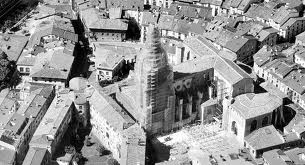
Ea, The Shortest Name for a Beautiful Unspoilt Town
Ea is the name of the small river that crosses this picturesque little town located just 50kms from Bilbao, on the coastal road that leads to the Gernika estuary from Lekeitio. Ea was founded on the XVI century by fishermen from the neighbouring hamlets, that sought a permanent port for their fishing boats. They found this little natural harbour and established there.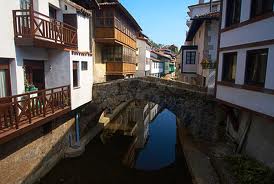 The town consists mainly of a single street and a river crossing it from beginning to end, sided by fishermen houses and ending in a natural harbour and a small beach that disappears on high tide. There´s a little chapel and also a small bar, where you can enjoy a drink and something to eat while enjoying the unspoilt landscape.
The town consists mainly of a single street and a river crossing it from beginning to end, sided by fishermen houses and ending in a natural harbour and a small beach that disappears on high tide. There´s a little chapel and also a small bar, where you can enjoy a drink and something to eat while enjoying the unspoilt landscape.
Not far, and on the same road, the villages of Natxitua and Bedarona, with breathtaking views over the ocean, and excellent restaurants serving real homemade food.